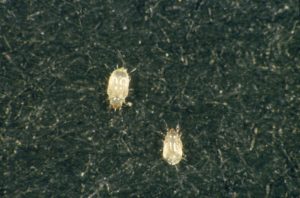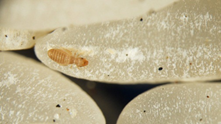 Booklice are small, almost microscopic insects that are grouped together in the insect order Psocoptera.
Booklice are small, almost microscopic insects that are grouped together in the insect order Psocoptera.
Booklice are very common in libraries, paper storage warehouses, packing and shipping warehouses that contain a lot of cardboard boxes, accounting and billing offices, large secretarial offices, and other places in which large quantities of paper are stored or used on a daily basis.
In houses, these small insects can be found infesting cereals, grits, flour, and grain in the kitchen or basement. They can be very common in the late summer when temperatures and relative humidity are high. The most favourable environment for booklice is one of high temperature and relative humidity.
These pests are found inside your food packages it is because it is too humid where you store your food. High humidity promotes mold growth in cereals and other stored food products, and this mold is what draws book-lice in. You can protect stored food by keeping them in sealed plastic containers and by keeping stored food areas dry.
Areas that have the most moisture will lure these pests in, areas such as basements, attics, closets, and other storage areas, which is why it is important to make sure that valuables stored in these areas are in sealed plastic totes.
Libraries often find the pest a real problem as they like to feed on the paste found in a book’s binding. Booklice also eat lichen and microscopic mould. They prefer the dark so will scuttle off if exposed to daylight and are often found in rooms where there is a lack of ventilation and light, such as kitchens. Most often they are found in cupboards and food, which can be very unpleasant.
Here are a few pieces of evidence:
Bedbugs, book lice temporarily close downtown branch of Lynchburg Public Library
Alissa Smith, The News and Advance │Nov 28, 2017
The downtown branch of the Lynchburg Public Library closed Tuesday afternoon due to a case of bedbugs and book lice, Library Director Marilyn Martin said.
The pests were confined to the new book area and traced to a single book, which was immediately bagged, Martin said. She declined to name the book’s title to preserve the renter’s privacy.
“Any public building that has people in and out has problems with lice, fleas, bedbugs, all kinds of things,” she said.
Meet The Tiny Critters Thriving In Your Carpet, Kitchen And Bed
Josh Cassidy, NPR │May 11, 2016
 A recent study published in the journal PeerJ took up the challenge of cataloging the large numbers of tiny animals — arthropods — that live in modern human dwellings. In 50 houses in and around Raleigh, N. C., the research team found about a hundred different species of arthropods in each home. The tally included familiar types — like flies, spiders and ants — but also some species that are less well known, such as gall wasps and book lice.
A recent study published in the journal PeerJ took up the challenge of cataloging the large numbers of tiny animals — arthropods — that live in modern human dwellings. In 50 houses in and around Raleigh, N. C., the research team found about a hundred different species of arthropods in each home. The tally included familiar types — like flies, spiders and ants — but also some species that are less well known, such as gall wasps and book lice.
As booklice are resistant to pesticides, they do not get affected by the pesticides.
In order to keep the booklice away we do require a strong result and for this, our product Combirepel™ manufactured by C Tech Corporation is an anti-insect aversive which repels insects.
Combirepel™ works on the mechanism of repellency. It temporarily inhibits the mating cycle of the insects. The product impairs the ability of the insects to reproduce, that is the insects will not lay eggs or the laid eggs will be infertile. The product causes feeding disruption in an insect by triggering an unpleasant reaction within the insect which might try to feed on the application.
The product temporarily blocks the reproduction system of the insects by hindering the release of the vital hormones for growth.
Combirepel™ is an extremely low concern, low toxic, low hazard, non-carcinogenic and non-mutagenic insect aversive. It does not kill or cause harm to insects as well as to the environment which indirectly helps to maintain the ecological balance.
Combirepel™ available in the form of the liquid concentrate can be mixed with paints and organic solvent in a predetermined ratio and be applied on the structure interior and exterior, ceiling, panels, so as to be protected from booklice.
Our product in the lacquer form can be applied topically to the applications. The lacquer is compatible with the surfaces wood, concrete, metal, polymer, ceramic, cables, wires which are already installed etc.
Our product in the form of wood polish additive can be mixed with wood polish and applied on the shelves, cupboard, doors, tables, chairs, and other wooden furniture to keep the booklice away from the application.
Our newly developed product in the form of a spray can be sprayed by anyone. It can be sprayed near the wooden articles, entrances, doors and windows, etc.
Combirepel™ is EU – BPR, RoHS, RoHS2, ISO, REACH, APVMA, BPR, NEA compliant and FIFRA exempted.
Contact us at technical.marketing@ctechcorporation.com to keep the pests away.
Also, visit our websites:
http://www.ctechcorporation.com/
http://www.rodrepel.com/
http://www.termirepel.com/
http://www.combirepel.com/
Follow our Facebook pages at:
1] https://www.facebook.com/Combirepel-411710912249274/
2] https://www.facebook.com/Termirepel-104225413091251/
3] https://www.facebook.com/Rodrepel-120734974768048/
Follow us on our Twitter pages at:
1] https://twitter.com/rodrepel
2] https://twitter.com/termirepel
3] https://twitter.com/combirepel
